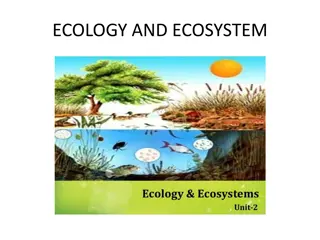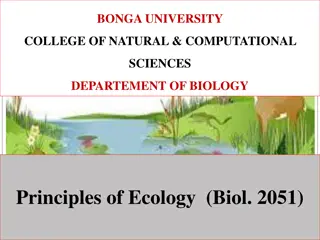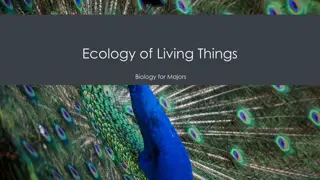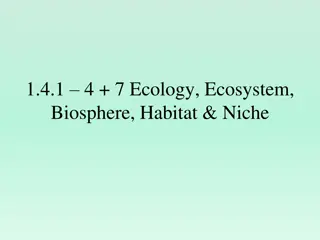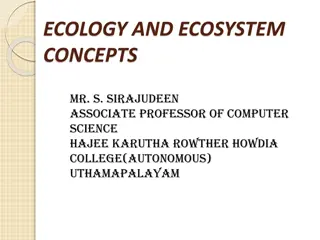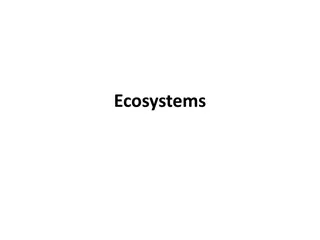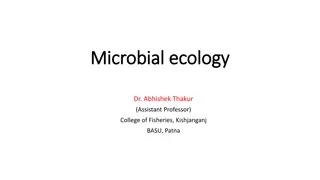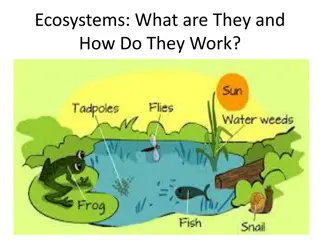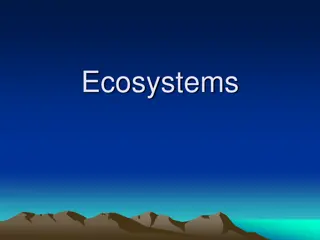Understanding Ecosystems and Disease Ecology
Explore the diverse types of ecosystems, including autochthonous, anthropurgic, and synanthropic ecosystems, and their impact on disease ecology. Learn about biotopes, biocenosis, ecological mosaics, and ecological interfaces, and discover how infectious diseases can be transmitted across these interfaces. Delve into the concept of ecological climax and the balance between host and parasite, with examples like endemic and epidemic infections. Gain insights into the unique interactions between plants, animals, microbes, and the environment within an ecosystem.
Download Presentation

Please find below an Image/Link to download the presentation.
The content on the website is provided AS IS for your information and personal use only. It may not be sold, licensed, or shared on other websites without obtaining consent from the author. Download presentation by click this link. If you encounter any issues during the download, it is possible that the publisher has removed the file from their server.
E N D
Presentation Transcript
Ecosystem Animals and plants that occupy them, and by their physical and climatic features. This unique interacting complex is called an ecosystem Types: According to their origin Autochthonous ecosystems Anthropurgic ecosystems Synanthropic ecosystems
Ecosystem Autochthonous ecosystems Greek word: autos: itself chthon: the earth or the land ous: deriving Ex. Tropical rain forest, desert Anthropurgic ecosystems Greek word: anthropos: man rooterg: to creat, to produce Ex. Cultivated Pasteur & town Synanthropic ecosystems Greek word: syn: along with anthropos: man Ex. An example is a rubbish tip, harboring a variety ofvermin (Leptosirosis)
Ecosystem Biotope: A biotope is the smallest spatial unit providing uniform conditions for life An organism's biotope therefore describes its location A biotope can vary in size Ex. Caeca of a chicken for coccidia, an area of poorly drained land for Fasciola hepatica infection of cattle Different from niche which describes the functional position of an organism Biocenosis A biocenosis is the collection of living organisms in a biotope The organisms include plants, animals and the microorganisms in the biotope Major biotic communities are biomes
Ecosystem An ecological climax An ecological climax traditionally is said to have occurred when plants, animals, microbes, soil and macroclimate have evolved to a stable, balanced relationship Infection is there: Endemic infection The balance between host and parasite: In-apparent infection If balance break: Epidemic infection Ex. Bluetongue, in-apperent infection in indigenous sheep in South Africa due to ecological complex. The importation of exotic sheep (European breed) represented a disturbance of the stable climax
Ecosystem Ecological interfaces An ecological interface is a junction of two ecosystems Infectious diseases can be transmitted across these interfaces Ex: Transmission of yellow fever The virus is maintained in apes in Africa in an autochthonous forest ecosystem Aedes africanus: transmits the virus between apes A. simpsoni: bridges the interface between the autochthonous forest ecosystem & the anthropurgic cultivated savannahs
Ecosystem Ecological mosaics An ecological mosaic is a modified patch of vegetation, created by man, within a biome that has reached a climax Infection may spread from wild animals to man Ex. The helminth infection loiasis is transmitted by arthropods between man, living in small forest clearing, and canopy-dwelling monkeys. Ex. Clearing of the forest canopy encourages a close cover of weeds on the ground, creating conditions that are favourable for the incursion of field rats with mites infected with scrub typhus, which form mites infected with scrub typhus, which form mite islands and the resulting local areas of endemic scrub typhus
Landscape epidemiology The study of diseases in relation to the ecosystems in which they are found is landscape epidemiology Similar terms: Medical ecology Horizontal epidemiology Medical geography Investigations are: qualitative in nature Involves the study of ecological factors that effects the occurrence, maintenance, and transmission of disease
Landscape epidemiology Nidality: foci were natural homes of these diseases & were called nidi (Latin: nidus = nest) Many arthropod transmitted infections present in the steppes were also limited to distinct geographical areas The presence of a nidus depends on its limitation to particular ecosystem An area that has ecological, social, & environmental conditions that can support a disease is a nosogenic territory Nosoarea: is a nosogenic territory in which a particular disease is present
Landscape epidemiology Objectives: Prediction about the occurrence of disease Facilitates the development of appropriate control strategies Ex. Leptospirosis Tularemia Kyasanur Forest disease



